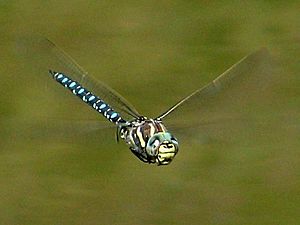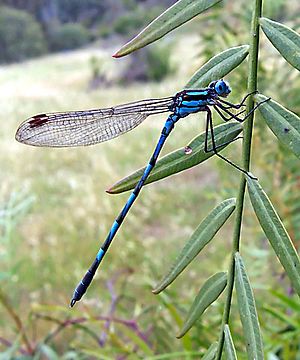Odonata facts for kids
The Odonata are a fascinating group of flying insects. This order includes both dragonflies and damselflies. Like many other flying insects, such as flies, beetles, and butterflies, Odonata have been around for millions of years. They first appeared in the early Mesozoic era.
You can easily tell the two main types apart by looking at their eyes and how they rest their wings:
- Dragonflies (called Anisoptera) have eyes that are close together. When they rest, their wings usually stick out to the sides or point upwards.
- Damselflies (called Zygoptera) have eyes that are set far apart. When they rest, their wings are typically held together along their body.
All Odonata start their lives in water. Their young forms are called 'nymphs'. Both the nymphs and the adult insects are carnivores. This means they eat other animals, mostly other insects. Adult Odonata can land, but they don't walk much. Their legs are specially made for catching prey while flying.
What Do Odonata Look Like?
These insects have some very clear features. They have large, rounded heads. Most of their head is covered by huge compound eyes. Their legs are perfect for grabbing other insects right out of the air.
Odonata have two pairs of long, clear wings. Each wing can move on its own. They also have long abdomens. On their heads, they have two small eye spots called ocelli. Their antennae are quite short. Their mouths are on the underside of their head. They have simple chewing mandibles to help them eat their prey.
Images for kids
-
The giant ancient dragonfly ancestor, Meganeura monyi. It lived in the Upper Carboniferous period. Its wingspan was about 680 mm (27 in).
-
Two azure damselfly couples (Coenagrion puella) laying eggs.
-
A male Onychogomphus forcipatus.
-
A Libellula depressa resting.
See also
 In Spanish: Odonato para niños
In Spanish: Odonato para niños












